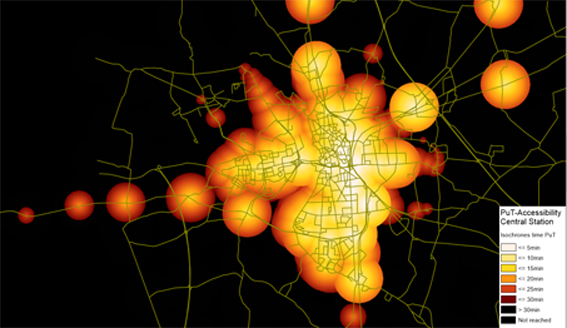Isochrones describe locations that have the same temporal distance to a point. PTV Visum allows you to select one or multiple network objects and have the journey time between these network objects and all nodes, zones or stop areas calculated. The isochrones can then be displayed graphically based on a classification of the calculated time periods of network elements (User Manual: Setting graphic parameters for the display of isochrones).
Typical use cases for this functionality are analyses of PuT service gaps and PrT journey time analyses for important destinations.
Isochrone calculation may also be based on other parameters besides the journey time, e.g. on impedance. This allows you to use isochrones for the analysis of accessibility.
If several network objects are selected for isochrone calculation, the shortest paths between the selected network objects and the link section is calculated for each link section. The shortest of these shortest paths then determines which accessibility interval is assigned to the network object.
Isochrone calculation does not only allow you to create a graphically appealing display of accessibility. The data obtained through the calculation is saved with the nodes, zones or stop areas and is so available as an attribute for further use. Isochrone calculation is carried out separately for the transport systems PrT and PuT. The results, however, may be displayed together in graphs or tables.
In addition to a display of the calculated isochrone time, you can show a spatial extrapolation to the area (2D display)

Image 238: PuT journey time to destination: 2D display

